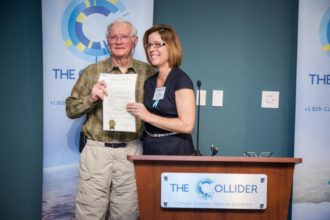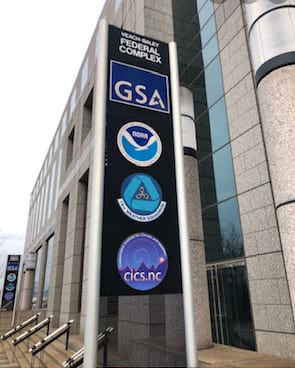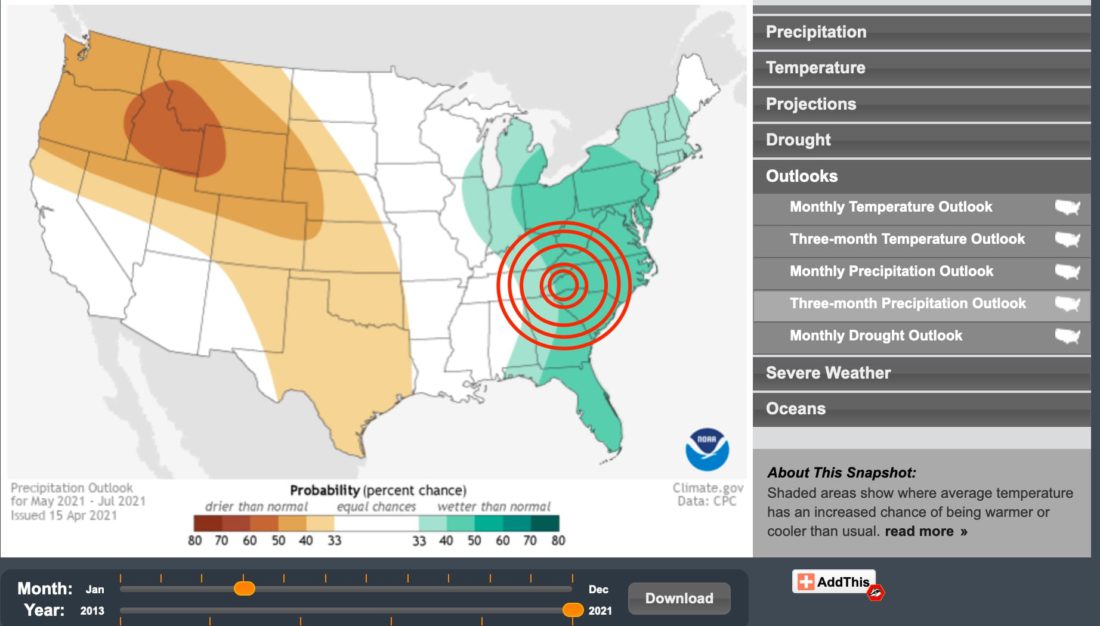By Tom Fiedler, Asheville Watchdog
Five years ago, entrepreneur and philanthropist Mack Pearsall thought he had discovered Asheville’s path to great wealth and world acclaim. Not through its beer; not because of its natural amenities.
Rather, in this time of global climate concern, the 84-year-old descendant of a pioneering North Carolina family believed Asheville could prosper by monetizing a unique yet little-known asset: Its federal archive of climate and weather data — the largest such collection among all the nations on Earth — curated by a local talent bank that includes several Nobel laureates and scores of climate scientists.
Pearsall joined the call to rebrand Asheville as “Climate City,” and he invested more than $2.5 million to catalyze this dream. Forbes magazine said it wasn’t “far-fetched to think of this small city, nestled in the Blue Ridge mountains of North Carolina, as an emerging Silicon Valley.”
But so far? Mostly crickets.
Asheville’s scientific talent, Pearsall says, his North Carolina drawl tinged with disappointment, “doesn’t want to be unleashed.”
Not just beer, bears, and Biltmore
Although the self-described “impatient futurist” harbors his doubts, many others remain optimistic that the day is coming when the city will be known as much for its intellectual capital as it is today for beer and bears, though perhaps not as quickly as initially hoped. Nobody questions the potential value of the data just waiting to be digitally mined and sold in a marketplace increasingly aware of the connection between sustainable life and changing climate.
Accessible through computers run by some 500 federal, state, and university scientists in Asheville’s downtown Veach-Baley Federal Complex are answers to questions both trivial and vast beyond imagination.
Want to understand why Texans froze this past February, or why California has been racked by wildfire in recent summers? Do you want to chart the fluctuations in the sun’s surface temperature, or at the ocean’s depths, over the past several decades? How do rocket scientists calculate the impact of deep-space temperatures when planning a Mars landing?
Come to Asheville. It is no exaggeration to say that the answer to every quantifiable question about climate and weather here on Earth and throughout the solar system lies in the more than 40 petabytes of data stored in the Asheville computer system, according to John Bateman, a spokesman for the National Centers for Environmental Information (NCEI), which operates the facility and employs some 400 science professionals and support staff. It is part of the National Oceanographic and Atmospheric Administration (NOAA), perhaps best known for the space program and ocean research.
How much is 40 petabytes of digital storage? The Library of Congress is believed to be the biggest library in the world. Forty petabytes is the equivalent of 2,000 Libraries of Congress. And the archive grows with each passing second, fed by satellites and weather sensors around the globe.
And what can be done with this data? Governments use it to predict weather patterns and to chart evidence of global warming, which they have done for three decades. The data are essential to space exploration and agricultural forecasts. Military strategists use Asheville’s data repository when planning operations affected by weather and to prepare for conflicts created by population displacement, which is often caused by drought and famine related to climate-change disruption.
For this reason, the U.S. Air Force’s 14th Weather Squadron operates inside the Asheville federal complex and not on a military base. It employs weather forecasters and cyber scientists, not pilots.
Asheville’s “Big Data Guy”

By law, however, the information isn’t for government eyes only. Entrepreneurs like Pearsall believe much of it can be packaged and sold by consulting companies in the emerging field of climate services. Several dozen of them are already based in Asheville, or with offices here. They warn government entities and private investors about the risks specific locales may face because of climate change, such as the increasing frequency of catastrophic storms, flooding, fire and paralyzing heat.
Human lives and vast sums of money are at stake. In an interview for this article, Pearsall said he sold his investments in oceanfront hotels because he learned from data produced by the NCEI staff in Asheville that these properties would inevitably be flooded — and worthless — in just a few years.
“I am now a big data guy,” he said with a chuckle.
Pearsall grew up near Rocky Mount in a prominent farming and political family, the son of a former president of the state Senate, Thomas J. Pearsall. He was sent to Asheville to attend the then-Asheville School for Boys in the 1950s and acquired an affection for the region that lured him back a decade ago. But not for retirement, a concept he still doesn’t comprehend. When Pearsall learned about the federal data archive he asked himself two questions: “Can we find ways to mine that data, to commercialize it? Can somebody write a business plan?”
Safe from enemy attacks
How Asheville came to be the depository for this data trove is mostly the accidental collision of geography and serendipity. In 1870, President Ulysses S. Grant, who learned in the Civil War how weather affected military battles, ordered the federal government to collect and archive weather records. Over the decades, these paper records were kept in ever-expanding locations, especially in and around Washington, D.C., and in New Orleans.
In the aftermath of World War II and with the hardening Cold War with the Soviet Union, the military archivists raised concerns that this data, swelled by records captured from Germany and contributed by British and other allies, would be vulnerable to future enemy attack on these coastal sites. Where to move them?
“The government just happened to have this very large building,” said David Easterling, who manages the current data archive and assembles the technical information in the quadrennial National Climate Assessment report (which the Trump administration tried but failed to quash in 2020). That “very large building” is the Grove Arcade in the heart of Asheville, which the government bought in 1943.
That proved convenient in 1951 when the U.S. Weather Bureau, the Air Force and the Navy combined their collections to form the National Weather Records Center and located it in the Grove Arcade. Mary Spivey, science editor at the National Environmental Modeling Analysis Center at the University of North Carolina-Asheville, said the Grove Arcade met the government’s criteria. It had ample storage space, was safe from coastal storms and enemy attack, and was within a day’s train travel from the nation’s capital.
The paper records and punch cards have since been replaced by digital storage. With no more need of its space, the government left the Grove Arcade in 1995 and the city of Asheville acquired it in 1997. The National Weather Records Center, after several other name changes, became in 2015 the National Centers for Environmental Information under NOAA, with its office in the Asheville federal complex.
Despite this history, it may surprise many Asheville residents and most visitors that the city is home to the one federal organization charged with “managing data from the bottom of the ocean to the surface of the sun.”
A Silicon Valley for climate science?

To Pearsall, ever in search of the next new thing, it seemed obvious that Asheville should be to the climate science industry what Silicon Valley is to the World Wide Web. He firmly believed that Climate City could become a defining aspect of Asheville’s reputation. But he recognized that this city, unlike Silicon Valley, had some weaknesses, among them a remote locale hiding the data trove from venture capitalists; the absence of a world-class research university with armies of grad students and academics hungry for projects to tackle; and no gathering place to draw this talent where they would interact.
Pearsall couldn’t do anything about the airport. But “in my naivete,” he said, he thought he could fashion an alternative to a research-university environment and create the gathering place to knit together the elements needed. He saw the potential for a solid foundation in two existing programs: The National Environmental Modeling Analysis Center at the University of North Carolina-Asheville (called NEMAC), and the North Carolina State University Cooperative Institute for Climate and Satellites, a collaboration among North Carolina universities, the University of Maryland and NOAA, all of which worked with the climate data.
NEMAC’s mission, created in 2005 as part of UNCA’s meteorology program, is to make the NCEI data accessible to the broader public through such things as data visualization. The NC State Institute was established with state and federal funding to assist the NCEI in the research needed to better understand the impact of climate change on communities, industries, the environment, and agriculture.
The Institute’s founding director, Otis Brown, a former dean at the University of Miami, feared its Asheville location would be a problem when he accepted the job in 2009. He was concerned that without a research-university base he wouldn’t be able to recruit top-quality climate scientists to Asheville. Also, he said, the city was widely seen as a place of “crystal gazing and tree hugging,” not intellectually rigorous research and productivity.
Brown said he soon realized that this drawback was overcome by Asheville’s “openness to environmental preservation,” which appealed to young scientists. And this cohort also welcomed opportunities to research climate change, an issue with humanitarian consequences. Brown quickly assembled a team of 20 scientists, “and one of them took a pay cut to come. They could see that the work they did could make a difference to society.” The team today has multiplied to about 100.
The Collider is launched
Having large numbers of climate scientists working in Asheville wasn’t enough to cause creative sparks to fly and draw the attention of deep-pocketed investors, Pearsall said. “Scientists and university researchers are too happy staying busy in their own labs. What I needed was to entice them to get together with business people who would learn about the work they were doing.
“That was the beginning of The Collider,” he continued. “It had two missions: Educating the public about climate change and finding ways to create jobs in this field.”
With an investment that he described as “several million dollars,” Pearsall leased the fourth floor in the former Wells Fargo building, just a block from the federal building. With landlord Claire Callens and 23,000 square feet of business space, Pearsall installed the accoutrements of a Silicon Valley-style campus: gourmet coffees and fresh pastries, lounges, conference rooms, and an auditorium large enough to accommodate major programs with headlining speakers.
The Collider drew its name from a term in physics where two particle beams collide at high speed, thus unleashing vast energy streams that impact others. The vision was that The Collider would become both a place for climate scientists and eager investors to mingle at conferences and talks, as well as an accelerator and incubator for start-ups.
Pearsall and other founding members set about recruiting staff and like-minded renters. They created a members’ network of federal and state climate scientists, academic partners, government agencies, businesses (many with headquarters across the globe), and nonprofit organizations. Membership now numbers more than 100, according to The Collider’s website (www.thecollider.org).
Pearsall said his goal in launching The Collider was simple: “To come up with something that will do good and also create jobs.” He told the Forbes magazine writer, “Let the word go forth, if you have an idea with climate data that you can commercialize, The Collider is open for business. Come here and we’ll make your dream come true.”
An auspicious beginning
The Collider enjoyed an auspicious beginning, opening in early 2015 with a program featuring federal Transportation Secretary Anthony Foxx. It gained momentum when former Coca-Cola executive James McMahon, who in addition to high-level corporate experience was a senior adviser to the NCEI director and had earned graduate degrees from Harvard and MIT, took over as CEO. McMahon in 2017 then blazed the path that Pearsall envisioned will be followed by many others: He created a start-up called The Climate Service and developed the Climanomics Risk Analytics Platform in collaboration with IBM. According to its website, the platform’s users can quantify the financial risk they may face because of climate disruption, whether it strikes next year or in 80 years.
Another Collider founder, former NEMAC director Jim Fox, created a company using the data trove to advise local governments in “climate resilience” planning — that is, how to recognize their vulnerabilities to climate-related catastrophes and how to prepare plans enabling them to bounce back after one. Clients of the company, NEMAC-FernLeaf, have included such metropolitan areas as Miami Beach, Fort Lauderdale, Charleston and, by the way, Asheville.
(Fox said in an interview that Asheville’s greatest risks, like those faced by the coastal cities, relate to water. Here, however, the threat is posed by torrential rains that create flash floods and those that result in landslides. The NCEI data show that, as local temperatures rise because of global warming, so will the intensity and frequency of rain. And why is that a major risk? “In Asheville, the land suitable for building is mostly between the river and the rocks,” Fox explained).
Several companies have been formed by former NOAA veterans who worked with the data. Marjorie McGuirk founded CASE Consultants International with Eileen Shea, an ex-White House environmental staffer, and Scott Shuford, a former Asheville planning director. The firm’s name is an acronym for Climate Arts and Sciences Expertise. Its primary focus is advising corporations and government agencies about potential disruption from climate change. Recently, Shea and Shuford delivered a transportation report for two cities in the American southwest, forecasting that, with increasing summer temperatures, fully loaded 757 aircraft wouldn’t be able take off from their airports because thin, hot air provides inadequate lift.
Without exception, these entrepreneurs credit their successes to knowledge gleaned from the federal data archives, and they predict others will soon follow.
“Asheville is close to critical mass,” said Shea. “There will be an explosion and Asheville won’t be known for drum circles and crystal gazing, but as a place with a knowledge economy based on climate change.”
Money-making potential untapped
Still, Pearsall’s once-unbounded optimism for Asheville to make real its claim as Climate City has cooled. So has his dream of seeing The Collider become a 21st century version of Bell Labs, whose researchers spun off scores of technology companies in its near century-long existence. He admits to being disappointed in the modest number of home-grown success stories and blames his own “naivete” in expecting more.
“I had the idea that you could make scientists into business people, but I’ve found out that’s impossible. I thought there would be scientists with pent-up demand” to use their talent to make money, Pearsall continued. “I ultimately found out that most of the talent didn’t want to be unleashed.”
Clark Duncan, senior vice president of the Asheville-Buncombe Economic Development Coalition, shares some of Pearsall’s disappointment in the slow pace of outside business interest in monetizing the data. But, unlike the entrepreneur, he counsels continued patience and remains optimistic.
“I like to think that we’re just a little ahead of the opening of a mass market [for climate data],” Duncan said. He draws a comparison to the internet, a government- and university-financed innovation that took years to draw private investment, and then only when its money-making potential began to emerge.
Also giving him hope is the Biden administration’s critical focus on climate change, a total reversal of his predecessor’s disdain for climate science. As President Biden sets ambitious goals in this area, “you’ll see industries globally responding and rushing to catch up,” Duncan said, pointing to growing investments in sustainable energy, automobile efficiency standards, and more.
All this may well be. But Pearsall’s skepticism also rests on another issue: Asheville’s laid-back lifestyle. He recalled a conversation over coffee and pastries at The Collider with the founder of a small, successful start-up. “I asked him why he wasn’t eager to grow so he could make more money. And he said, ‘Oh, it might interfere with my mountain biking.’ ”
But he says he has no second thoughts about risking his money on the venture and still predicts Asheville will emerge as an important “node” in a global network of climate-science industries. He said that as a young man in the 1960s he learned that failure also is defined as refusing to take a risk. That’s when he rejected the chance to join a friend in starting a southern-themed restaurant because he didn’t see room in the market for another burger chain. It was called Hardee’s.
“I won’t make that mistake again,” he said.
Asheville Watchdog is a nonprofit news team producing stories that matter to Asheville and Buncombe County. Tom Fiedler is a Pulitzer Prize-winning political reporter and former executive editor of The Miami Herald, now living in Asheville. He can be reached at tfiedler@avlwatchdog.org.



Asheville will be known for its “intellectual capital”? LOL that is hilarious. Half my idiot neighbors still have Trump stickers on their loud obnoxious trucks. (by the way boys, we all know exactly for what you are (over) compensating.)
Dream on old man.
Pearsall should have known better than to make Asheville anything aside from Beer City.
He would have been wise to build up operations in the RTP or Charlotte and simply keep up appearances in Asheville. Any self-aware business person knows that Asheville does not attract greatness of any kind.
No…and soon the bears will be eradicated or “relocated” drastically lowering the avg IQ in asheville to the lower 40’s.
What role did the Cecil family, perhaps Asheville’s most successful builders of commercial ventures, have in Pearsall’s plan?
This other map still prevails. The west may be a desert physically, but the east is a different kind of desert:
https://www.businessinsider.com/income-inequality-upward-mobility-map-us-2018-2
Props to the NOAA Climate Program Office’s Climate.gov Data Snapshots for the header image: https://climate.gov/maps-data/data-snapshots/start.